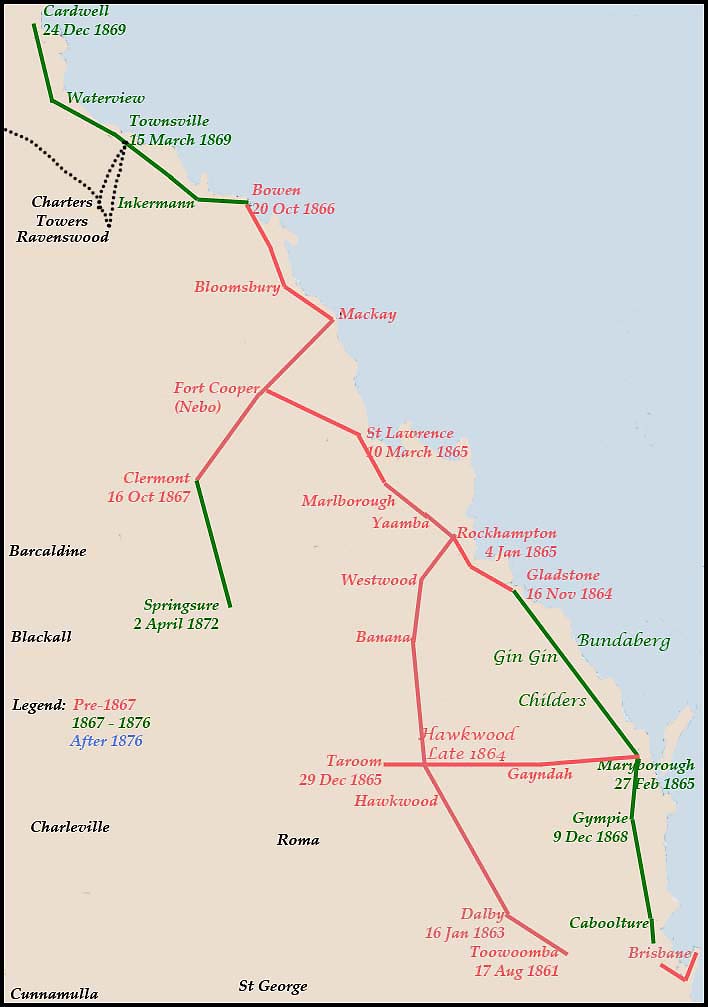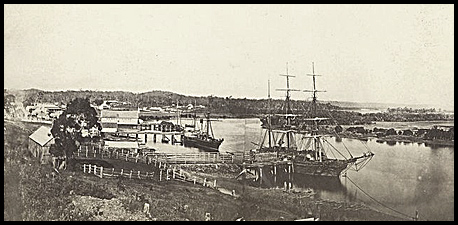Telegraph lines along the east coast.
- Australia 1901-1988
- New South Wales
- Overview of NSW
- Telegraph lines
- Telegraph Offices
- Date stamps
- Forms
- Envelopes
- Instructional annotation
- Collect
- Delayed
- Free
- Immediate Urgent
- Reply paid
- Rates
- Stamps
- 1871 Telegraph stamps
- 1885 proposal
- 1893 proposal
- Queensland
- South Australia
- Tasmania
- Victoria
- Western Australia
- International
- Special aspects
The sections of the east coast line described in detail after the overview are:
- lines around Maryborough;
- from Dalby to and beyond Rockhampton;
- Mackay to Bowen (Port Denison) and Cardwell.
Following the significant construction phase in 1861 to link the new Colony of Queensland to New South Wales, there followed a period of intense planning especially of the Northern line. This line was to begin at Toowoomba and follow the coastal region keeping wherever to the east of the Great Dividing Range to avoid the significant construction problems.
The construction priority was to extend the lines of communication as far and as quickly as possible to country regions rather than service Brisbane and the larger towns only. The exception to this policy was to include lines which were of necessity for economic and safety reasons. It is for these reasons that, in August 1863, the Government announced it intended to construct a telegraph line of 89½ miles from Brisbane to Cape Moreton. The opportunity was taken to open five Offices along this line. The beginning of this line was later moved to the Observatory.
In the Legislative Assembly of 19 June 1861, the Colonial Secretary "proposed the following item in connection with the Telegraph Department:
- From Toowoomba to Gayndah (via Dalby) with a branch line to Maryborough;
- From Gayndah to Rockhampton via Gladstone".
Total for both items was estimated to be £22,000. The whole distance was about 440 miles with an estimated cost of £50 per mile.
It was thought but fair to give the northern districts the benefit of telegraphic extension. In extending our telegraphic lines, we are but following the example of New South Wales and Victoria. This line was but intended as the commencement of a further extension to the Gulf of Carpentaria"
On this motion, considerable discussion took place and it was ultimately rejected on the motion of Mr. O'Sullivan that the item be reduced to one shilling.
 |
The main line north along the east coast began at Toowoomba. That station would therefore reduce the load on the Brisbane office although it would require manual repeating of messages from the north and later from the western stations.
The push to the north was very quick and each section spanned long runs. From Toowoomba to Rockhampton the line was constructed through Hawkwood well inland away from the coast.
|
The Rockhampton to Gladstone line gave telegraphic access to Gladstone's Port Curtis which, at that time, was just beginning to operate. About 1865, a short line was constructed from Rockhampton north to the pilot station at Keppel Bay. In the same area, the line was being pushed south from Gladstone with tenders being called for the 120 mile Gladstone to Gin Gin line in December 1872. |
 Port Curtis, Gladstone showing the ships. Taken in 1868. |
By 1864, 487 miles of line in Queensland had been constructed (according to Cracknell's 1865 Report). There were 11 telegraph stations opened on the northern line to Bowen before May 1867.
Concurrent with this activity was the construction of an additional east-west line from Maryborough via Gayndah and Hawkwood to Taroom. This line linked the "inland" East Coast line to the sea coast. Wiring on the Maryborough to Gayndah section was completed in early February 1865 and the line to Gayndah opened at the end of that month By the end of 1864, the 142½ mile line from Maryborough to Hawkwood had been constructed. The line from Hawkwood to Taroom was commenced during the second half of 1865 and the Taroom Telegraph Office was opened at the end of December 1865. The country side was difficult for the teams as well as for the repairers.
Woody Island
The lines out of Maryborough also involved the construction, in 1869, of an extension beyond Maryborough east to the Woody Island Lighthouse in Hervey Bay. The line was about 30 miles in length including a section to the mainland using a submarine cable about 5 miles in length. Cost was estimated at £1465 and the Legislaive Assembly had been informed on 7 February 1868 that money was approved in the estimates.
Unfortunately, after having been in use for 18 months, the cable connecting the mainland with the lighthouse ceased to work in August 1870. An examination of the defective cable revealed two broken wires in the conducting strand and a puncture in the gutta percha covering. Both problems were not apparently faults during manufacture. The cable had been sent from England in an iron tank filled with water and, on being tested before removal from the ship by one of Siemen's galvanometers, the insulation was found to be perfect. A continuous test had also been made during submersion of the cable and no fault had been detected. Apparently the defect had gradually developed through the action of the electric current to the extent that it finally interrupted communication.
Once the cable was repaired, however, it continued to operate perfectly. Over the next 50 years or so, the Woody Island lighthouses played a critical role in maritime monitoring and safety. In 1870, an extension from Woody Island to the Lighthouse at Sandy Cape, (north extremity of Frazer (later Fraser) Island) was proposed. That extension spanned 46 miles and required six miles of submarine cable.
In February 1896, another repair to the cable run to Woody Island was planned using the steamer Muriel Bell. A few hours before departure, another steamer - the Burwah - collided with the Muriel Bell while she was at the Municipal Wharf. She was badly damaged and there was no replacement vessel available. Hence the Woody Island cable had to wait until the Muriel Bell was repaired.
The Maryborough coast line.
A second line from Maryborough to Brisbane was also constructed in 1868-69 along the coast. This went through Gympie (9 December 1868) then 110 miles through Cabulture (later Caboolture) to Brisbane (completed on 14 July 1869) and provided an important alternative route for messages from Brisbane which could now be repeated at Maryborough. That relieved the overcrowded northern line. The cost was £35/0/5 per mile exclusive of buildings and office fittings. The timber used was mostly bloodwood and iron bark. The wire was No. 8 galvanised iron and the insulators were double umbrella porcelain.
After Federation, railway lines were constructed from the coastal regions inland. Telegraph lines were constructed along the railways to service various small communities. In December 1910, number of railway lines were being planned including the line from Caboolture to Woodford and Kilcoy. This line was constructed by October 1913. The cost of construction, including telegraph lines and surveys, but not including land resumed, was estimated at £97,000 with £4000 added for rolling stock. An associated line was that from Gayndah to Mundubbera.
A third line from Brisbane to Gympie was erected in the second half of 1881.
The telegraph line was pushed further north from Hawkwood without a pause. In January 1865, the 106 miles from Rockhampton to Broad Sound (St. Lawrence) was poled and the wiring party completed their task in March.
Construction of the line from St Lawence to Bowen began in August 1865. The line moved north-west and inland a little to Fort Cooper (later Nebo) before returning to the coast at Mackay. The reason for the movement away from the coast is not known but it presumably was to avoid some of the coastal difficulties and provide better conditions. The coastal area had no inhabitants while a number of pastoralists had settled around Fort Cooper from about 1860 and so they would benefit from having access to the line.
Construction of the line from St Lawrence was delayed first due to wet weather at the beginning of 1866 and then "to other casualties". By June 1866, 165 miles had been completed and it was hoped that the remaining 86 miles would be completed by November.
The line through Fort Cooper soon after enabled a line from Clermont to the south-west, in a new area of Queensland, to be planned to link with the North Coast line to Bowen (Port Denison). The section from Rockhampton to Clermont was estimated to cost £6,000.
The line from Mackay to Bowen was completed in October 1866. There was then a pause before the 100 mile line was constructed via Townsville to Cardwell. It was completed on 24 December 1869 and cost £34/6/1 per mile. The Cardwell office opened on 3 January 1870. The poles were mainly ironbark and bloodwood with some blue-gum. The insulators were Siemen's and Wardens with No. 8 wire. Within a few years, Cardwell was selected as being the starting station for the line to the west to the Gulf of Carpentaria. On 6 August 1885, tenders were called for the clearing and renewal of poles on the Townsville to Cardwell line via Ingham.
During the early 1900s, a line from Bowen to Townsville along the coast via Ayr was also constructed.
For a number of reasons, Bowen became established as the main repeating station for the north in the early 1870s. Part of the reason was the discovery of gold at Ravenswood. The lines resulting from this development are discussed elsewhere. As Bowen - and so some extent Townsville - developed, the importance of Cardwell as a major station diminished.
There was always discussion about respective roles. For example, the Northern Miner of 20 February 1884, noted: "Mr. O'Kane said that the chief fault of the slow delivery of telegrams was in having Bowen only a repeating station; they ought to have a repeating station at Townsville".